Denneroll
Lumbar Denneroll
No matter what makes lumbar lordosis abnormal, Denneroll can help get it back to normal.

Lifting injuries, falls, poor posture, and poor ergonomics can contribute to abnormal lumbar lordosis, a condition that carries the risk of diminished nerve, ligament, and muscle function. Thoracic kyphosis can ultimately lead to health-related disorders, and increased potential for back pain and injury.
When viewed from the side, the lumbar spine should have a natural J-shaped curve, with more curvature at the bottom. The Lumbar Denneroll orthotic helps patients restore that curve by providing a gentle stretch to coax the spine back into its ideal curvature. When used properly, the Lumbar Denneroll device can reduce the risk of damage to nerves, muscles and ligaments, while helping to relieve pain and muscle tension.


The Lumbar Denneroll
With the Lumbar Denneroll, you can provide relief and improve health for back pain patients. Designed by chiropractors and endorsed by CBP®, The Lumbar Denneroll provides a gentle, but effective, stretch to coax the lumbar spine back to its ideal curvature, or lordosis (see Figures 6-8 below).Which relieves pain and reduces the risk of nerve, ligament, and muscle damage.
When properly used, the DENNEROLL can assist in relief of pain, muscle tension, and recovery from disc injury. Enhanced patient comfort and improved health are the goals.

The thoracic translation support system is designed to assist in the reduction of posterior thoracic cage translation in combination with a reduced Lumbar Lordosis. The main support has been uniquely contoured to allow the scapula and shoulder region to roll back into slight retraction and external rotation while the patient is lying supine on the support.
The thoracic support block is approximately 50mm in height (2 inches). The block comes with a 20mm elevation block that is designed to be used underneath the support block. When used in combination, the two blocks total 70mm and create a significant anterior translation of the thoracic cage during Lumbar Denneroll Application.

Denneroll Placement
There are three areas of the low back appropriate for DENNEROLL application: Lower lumbar, Mid-Lumbar, and Thoraco-Lumbar. See Figures 9-11 above. Only a radiographic and postural analysis can determine which Denneroll Placement is right for the individual patient. The DENNEROLL device should only be used on a firm surface such as the floor, or a bench so that an effective stretch can be applied to the lumbar tissues.

Denneroll Sizes
Currently there are two Adult Lumbar Denneroll sizes: Adult Medium with a white top and Adult Large with a gray top.
- The Adult Medium is recommended for persons that are approximately 5’9” and under, for stiff non-flexible spines, or for patients that are just beginning treatment and having significant low back symptoms.
- The Adult Large is recommended for persons that are above 5’9”, for very flexible spines and for the more advanced patient user.
- Postural translation of the ribcage can significantly influence the size of the Denneroll device needed. For more information see the thoracic support system immediately below:

WARNING: Certain conditions can contribute to increased risk of injury during cervical extension traction. If you experience any unusual symptoms including, but not limited to; increased pain, dizziness, headache, nausea, numbness, visual disturbances, muscle weakness, loss of coordination or function, please consult your spinal health professional before further use.
When lying on the Denneroll, it is best to keep your legs flat for the most effect on the Lumbar spine. However, at first for patient comfort and tolerance, the knees can be bent.
CONTACT CBP
CBP Seminars, Inc.
1160 Taylor Street Suite 100
Meridian, ID 83642
Phone: 208-939-0301
Fax: 208-209-6009
Email: [email protected]
Web: idealspine.com
LATEST ARTICLES
CONTACT CBP
CBP Seminars, Inc.
1160 Taylor Street Suite 100
Meridian, ID 83642
Phone: 208-939-0301
Fax: 208-209-6009
Email: [email protected]
Web: idealspine.com






